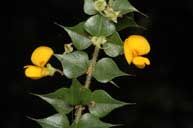In Flower This Week
A news sheet prepared by a Gardens' volunteer.
Numbers before each plant refer to temporary IFTW labels in the gardens.
Numbers in square brackets [ ] refer to garden bed Sections. Plants in flower are in bold type.
View past issues of 'In Flower This Week'.
10 June 2015
Podolobium aciculiferum click for larger image |
Today we will walk from the Visitor Information Centre (VIC) up the hill to the Acacia section.
- On your right in a pot is Banksia calophylla [Section 174,] with stiff, toothed grey-green foliage and small reddish-orange flower-heads hidden amongst the foliage. This plant is endemic to Western Australia and was known as Dryandra calophylla until 2007, when all Dryandra species were transferred to the genus Banksia by research botanists Austin Mast and Kevin Thiele.
- Further along on the right is Epacris reclinata [Section 174], with clusters of small white tubular flowers on wiry foliage. It is native to the sandstone areas of the upper Blue Mountains, west of Sydney.
- Also on your right is Epacris impressa [Section 174], a straggly bush with bright pink tubular flowers. The pink-flowered form seen here is often referred to as Pink Heath, and is the floral emblem of the state of Victoria.
- Still on the right is yet another species of Epacris, Epacris longiflora [Section 174]. It has thin tubular white flowers on a straggly light green bush. Its native range extends from the central coast of New South Wales to southern Queensland.
- On your left is Prostanthera phylicifolia [Section 210], or Spiked Mint-bush, which has masses of small mauve flowers on a loose shrub which is scrambling down a bank. It grows naturally in eastern mainland Australia.
- On your right is Thryptomene denticulata [Section 174], with arching stems bearing close grey-green foliage and pink flowers. It grows naturally in southwestern Western Australia.
- On the right is Chamelaucium ‘Cascade Jewel’ [Section 174], a cultivar of Geraldton Wax. It is an open airy shrub with purplish-pink five-petalled flowers with darker centres.
- Bear left up the hill behind the café, then right along the road behind the Rock Garden. On your right is Calothamnus tuberosus [Section 14], a stiff upright bush with spiky grey-green linear foliage. There are a few bright red fluffy flowers appearing. It is endemic to southwestern Western Australia.
- Also on the right is Eremophila oppositifolia [Section 14], a sparse bush with grey foliage and pinkish-white tubular bell flowers. This widespread species occurs in Western Australia, South Australia, New South Wales, Queensland and Victoria.
- Turn left towards the Red Centre Garden to see on your left Acacia oshanesii [Section 3], which is native to coastal New South Wales and Queensland. This tree has fine dark-green divided foliage with some fluffy yellow balls of flowers.
- Now bear right along a small dirt track towards the Eucalypt Lawn. On your right is Acacia falcata [Section 18], or Sickle Wattle, which is native to eastern Australia. It has large green phyllodes (which are flattened expanded leaf-stems) with clusters of small, pale yellow ball flowers.
- Acacia terminalis [Section 18], further along on your right, is a small tree whose range extends through New South Wales, Victoria and Tasmania. It has attractive dark green divided foliage with large cream balls of flowers.
- Turn right down the Main Path to see on both your left and right Acacia subulata, [Section 18], or Awl Leaf Wattle. It has narrow phyllodes and bears scented yellow balls of flowers for long periods of time. This wattle is endemic to New South Wales.
- Podolobium aciculiferum [Section 18] is on your left with golden pea flowers and sharply pointed dark green foliage. This plant grows naturally in coastal New South Wales and Queensland.
- On your right is Acacia consobrina [Section 18], a native of southwestern Western Australia. It is a low bush with grey phyllodes and large golden balls of flowers.
Rosalind Walcott
![Director of National Parks [logo]](../../../../images/dnp_90px.gif)







